Uncategorized
Don’t Miss the Big Searchlight Finale Tonight; Stand with Southern Dallas
Mayor Johnson is still a No-Show
At Shingle Mountain today
So we’re leaving the lights on to help him find us tonight
The company we’re renting these searchlights from promised a 25-mile view radius.
Help us learn if we got our money’s worth. Let us know if you can see it from where you are tonight and if you can,
take a picture and post it on
our FaceBook Event feed
Tonight’s light show is the big finale to our day-long action to help Dallas Mayor Eric Johnson find his way to Shingle Mountain and Environmental Equity.






Besides looking for our searchlights tonight, you can also…
1. Adopt a sign to help
Mayor Johnson Find His Way
We’re putting up 200 of these signs all over town. Want one near you? All you have to do is contribute what you can at our secure pay portal here, and make a request for a sign at the bottom of the form.
You can track where signs are popping up on this live Google map.
 Find one, take a sign selfie and send it in.
Find one, take a sign selfie and send it in.
Thanks.
2. Send a Letter To Mayor Johnson To Help Him find His Way to Shingle Mountain and Environmental Equity
Our ClickNSend letter app takes all of 30  seconds, allows you to add your own message, and tells Mayor Johnson and Dallas City Hall you support Environmental Justice. Thanks
seconds, allows you to add your own message, and tells Mayor Johnson and Dallas City Hall you support Environmental Justice. Thanks
3. Help us pay for these darn signs and searchlights.
We wanted to do justice to both the issues in Southern Dallas and the 50th Anniversary of Earth Day. If you think we succeeded please consider a contribution through our secure pay portal to offset the costs of a more memorable Earth Day 2020. Thanks.
Follow us on Facebook
Til Midnight:
#ThisWayMayor
Biggest Disappointment of the Dallas Climate Plan? Greens Giving Away Their Power For So Little in Return.
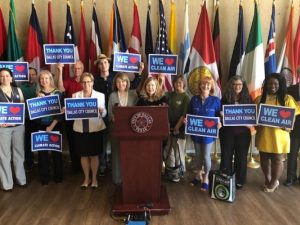
Who could have possibly foreseen? Many of the activists in this 2018 picture who lead the effort to secure half a million dollars for consultants to write a climate plan are now unhappy with the climate plan the consultants wrote. Photo by Linda Hamilton
There’s a lot of angst and disappointment among Dallas green groups over the draft of the consultant-driven Dallas Climate Plan released a couple of weeks ago and headed to a final vote in April.
Despite Mayor Mike Rawlings vowing to “adopt, honor, and uphold the commitments to the goals enshrined in the Paris Agreement” in 2017, the actual 2020 plan achieves less than 50% of the emission reduction goals by the deadlines set in that international agreement.
Since its unveiling, local green discontent with the Plan has been bubbling up in a variety of ways. There’s an appeal to join a protest rally at this Tuesday’s official roll-out of the Plan at the City’s day long “climate symposium” to show support for a “stronger,” and “better” plan. Another group’s online plea states that “many” of the Plan’s 93 action items are “inadequate” and not immediate enough. There are lists of demands that include the commitment to actually fund the recommendations proposed, accelerate vehicle and fleet electrification by a decade or more, and “more quantifiable actions” to insure the city meets its own goals.
What makes these criticisms both sad and instructive is that they’re coming from some of the same green groups that literally went door-to-door in 2018 trying to effusively sell Dallas residents on the idea of the consultant-driven climate plan they’re now faulting. Having campaigned and won City Council approval to spend $500,000 of the $750,0000 in earmarked “environmental funding” leftover from the city’s short-lived plastic bag fee, they were rewarded for that sales job by having their representatives appointed official “stakeholders” in the plan’s drafting.
That’s apparently all they got from the City for their effort. Because those representatives are now stoking the newfound discontent with the plan they presumably helped draft.
Was it naive of these groups to put their trust in the same City Hall that approved illegal gas drilling, Joppa batch plants, and Shingle Mountain? Undoubtedly. The largest disappointment with the Dallas Climate Plan isn’t the action items it does or doesn’t include, but the blank check of support it got from those who had the leverage to ask for more at the beginning of things. At exactly the time when they had the most real power to produce a more creative, effective Plan, they said no thanks and gave all the power to City staff and the consultants whose pay they had secured. That’s the original sin from which all other shortcomings flow.
Confronted with the City’s intent to create its own climate plan after Rawlings made that very public promise in 2017, a more successful effort might have tried to assemble some kind of Dallas Green Alliance-type response from the widest possible spectrum of groups, many of whom are experts in their respective interest areas – Urban Ag, Water, Solid Waste, Transportation, Environmental Justice, and Air Quality.
Despite the diverse interests, maybe it would have been possible to wrangle a grassroots residents’ plan that identified 1 to 3 make-or-break reforms or procedures out of a longer list of recommendations. At that point, with most green local groups on the same page about what they wanted from the plan, this coalition could have said to City Hall “If you want our support for that half million in consultants fees you have to promise X, Y, and Z be included in the adopting resolution.”
There are no guarantees such a path would have produced a better plan, but the tragedy is that it was never even tried.
All the original cheerleaders seemingly just wanted to cut a deal for a climate plan in name. For the most part, that’s exactly what they got. The only ones who seem surprised by its lack of serious content are the ones who signed-off on that superficiality.
Instead of building on reforms already negotiated up front, critics are now left to complain from the sidelines at the last minute, only weeks before the final vote. That’s rarely a recipe for successful change.
After Tuesday’s rollout, it looks like the full council might be briefed by staff on the Plan Wednesday, April 15th, with a symbolically-laden vote on the 50th anniversary of Earth Day, Wednesday April 22nd. Amendments are possible but need eight votes to pass a city council that has yet to be tested for its green bone fides.
Other “interest groups” have accumulated, organized, and leveraged their power to insure they weren’t cut out of the action at City Hall – the amazing LGBTQ Stonewall groups who are a force of nature in local politics, black and brown business associations, church and civil rights groups, and of course developers and the Citizens Council.
Some future Earth Day you’ll know the DFW green movement will have grown into a mature political force when it has the self-interest, wherewithal, and ambition to negotiate from a position of collective power. For now, among the costs we incur by the absence of that strategy are disappointing, timid climate plans.
Want to learn more about the Dallas Climate Plan process? Read our coverage:
February 2019: “All Plan, No Action: Dallas City Hall’s Approach to Climate Change”
March 2019: “Dallas Climate Plan’s ‘Public Participation’ is Neither Very Public nor Participatory”
May 2019: “Dallas’ Climate Plan Rolls Out Public Engagement Plan. Public is MIA.”
November 2019: “The Only Thing Missing in Dallas’ Climate Plan “Focus on Equity” is…any measure of Equity”
February 2020: “How the Dallas Climate Plan Baits and Switches on Air Pollution”
Neighbors Hold First Meetings to Reverse Racist Zoning In the Shadow of Shingle Mountain
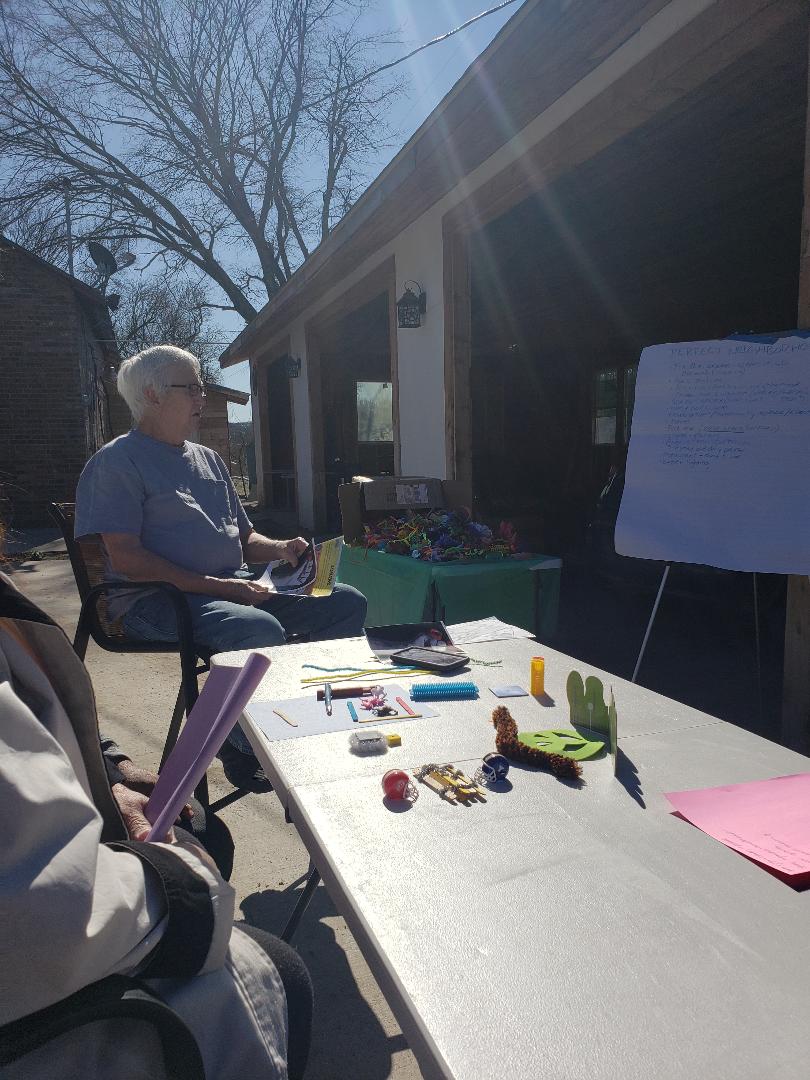 Gathering in an outdoor pavilion only feet away from the notorious Shingle Mountain, the illegal dump’s neighbors recently began to hammer together a very different future for what they want their community to look like.
Gathering in an outdoor pavilion only feet away from the notorious Shingle Mountain, the illegal dump’s neighbors recently began to hammer together a very different future for what they want their community to look like.
Using Legos, pipe cleaners, and construction paper Neighbors United members built a 3-D version of their new vision as part of the first wave of meetings in preparation for the upcoming “forwardDallas!” land use planning process.
Facilitated by The Inclusive Communities Project’s Jennifer Rangel and Downiwnders’ Chair Evelyn Mayo, the group was following up on its successful petition for “Authorized Hearings” to trigger a reexamination of how every tract in their part of the “South Central Corridor” should be zoned. That petition is now winding its way through City Hall and the group’s recommendations will be critical in getting things changed.
Even as they continue to fight for a full-clean-up the residents are doing their best to make sure their neighborhood isn’t victimized again by unscrupulous grifters like Shingle Mountain’s Ganter brothers or the City of Dallas’ own neglect. Their taking their fate into their own hands, in this case, one Lego block at at time.
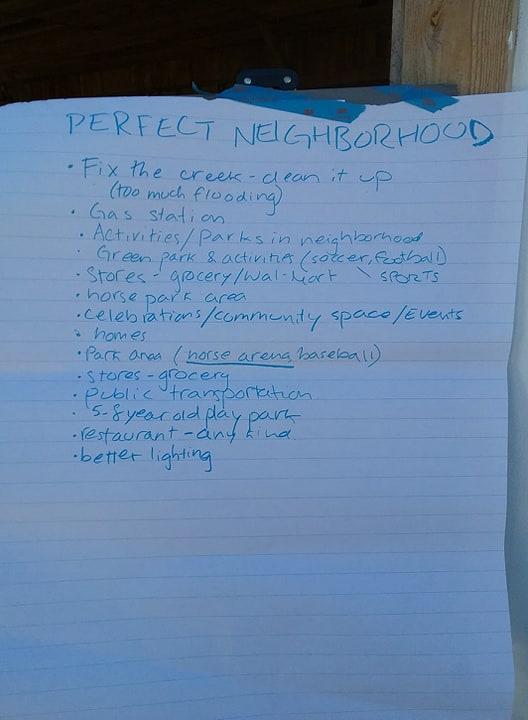
Last undertaken in 2009, “forwardDallas!” is a attempt to write a comprehensive plan for the entire city, block by block, that’s then (theoretically) referenced by residents, developers and City Hall planners in all future decisions. This time, there’s a grassroots campaign gearing up on behalf of environmental justice concerns in Southern Dallas using it to follow-through on previous promises to de-industrialize neighborhoods like Joppa and the South Central Corridors that are next door to the Great Trinity Forest but still dominated by heavy industry.
Obsolete racist zoning forces People of Color to live way too close to heavy industry polluters along the Trinity River floodplain. Success will mean undoing this kind of zoning in big chunks, improving public health and the chances of economic development in the process.
Important goals are restoring residency rights so everyone gets public notices, “down-zoning” tracts that aren’t being used by heavy industry now but could host them in the future, and pro-active pollution control measures new zoning could provide.
Zoning and land use decisions are a large reason why studies consistently show People of Color are exposed to more and higher levels of Particulate Matter air pollution than their white peers. Instead of continuing to battle Southern Dallas polluters permit by permit, zoning reform offers a way for residents to solve the underlying institutional problem. And because the “forwardDallas” review turbocharges the entire process, it offers the opportunity to make large gains faster.
Although the official start to “forwardDallas” isn’t scheduled until April now, Jennifer and Evelyn are getting a head-start so neighborhoods show up at the City meetings with something already in hand. If you’re interested in your neighborhood hosting one of their workshops, please contact us at: downwindersatrisk@gmail.com.
Downwinders And Southern Sector Rising Awarded Communities Foundation Grant for “forwardDallas!” Zoning Reform Campaign
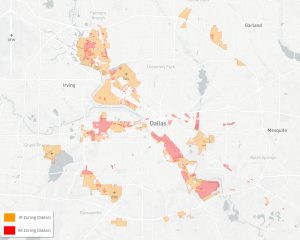
An important part of Downwinders’ 2020 agenda got a big boost this last month when we learned we’d received a $20,000 Communities Foundation of Texas grant to take on Dallas’ environmentally unsound and racist zoning as part City Hall’s upcoming “forwardDallas!” land planning process.
 Touted as a meeting-intensive opportunity to reshape Dallas neighborhoods by the residents who live in them, the last time the city went through “forwardDallas!” was also its first time, in 2006.
Touted as a meeting-intensive opportunity to reshape Dallas neighborhoods by the residents who live in them, the last time the city went through “forwardDallas!” was also its first time, in 2006.
With our allies at the Southern Sector Rising Campaign for Environmental  Justice, we proposed to use this new round of planning to reverse dangerously obsolete zoning in Southern Dallas where polluters are operating next door to homes, especially in predominantly black and brown neighborhoods like Joppa and West Dallas.
Justice, we proposed to use this new round of planning to reverse dangerously obsolete zoning in Southern Dallas where polluters are operating next door to homes, especially in predominantly black and brown neighborhoods like Joppa and West Dallas.
Employing the on-going Shingle Mountain scandal as a rallying cry, both groups see an opportunity to win real environmental justice progress if neighborhoods can be mobilized. Toward that end we’ll be engaging residents with door-to-door canvassing, neighborhood meetings, and appointments with officials from Pleasant Grove to West Dallas. Thanks to the Communities Foundation, we’ll be able to devote a sizable amount of resources to this campaign.
Working in our favor is the expertise of the recently-named “forwardDallas!” Chair District 11 Plan Commission Jaynie Schultz. Ms. Schultz earned an MA in Urban Studies from UTA, is Chair of the Plan Commission’s Urban Design Committee, and most importantly for this new assignment has been on the Plan Commission since 2014 consistently opposing the default dumping of new polluters in Southern Dallas in one battle after another.
Although this grant was written in part to help provide salary to our lone staff person, we’d really like to use the whole thing for program work. We can only do that if folks such as yourself respond with End-of-Year contributions and help us raise the $5-10,000 we need to pay the region’s only full time environmental community organizer.
Having the endorsement of the Communities Foundation is a huge plus for our local fundraising efforts and we’re very appreciative. Having your endorsement is even more important. Please help us stretch this grant. Thanks.
YES, I’LL HELP YOU MAKE THAT COMMUNITIES FOUNDATION GRANT GO FURTHER
Texas Misusing 17-Year Old Rural Air Pollution Model to Permit Inner-City Joppa Asphalt Plant
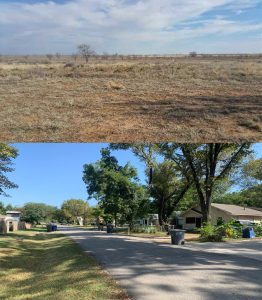
One of these is not like the other
What if you found out an industrial polluter was operating in your densely-populated neighborhood and the state told you not to worry because an obsolete computer model of the polluter’s releases 17 years ago and 500 miles away, in a desert, performed by the polluter themselves, said everything was OK?
That’s exactly the situation Joppa residents find themselves in as the Texas Commission on Environmental Quality (TCEQ) goes through the motions of renewing one of the permits of the many industrial polluters located in the community.
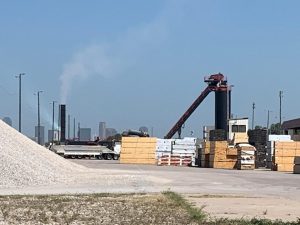 Austin Industries’ asphalt batch plant sits next to the Marietta Martin (TXI) concrete batch plant in Joppa, and both are in the Union Pacific switch yard and all of those are adjacent to the giant Tamko asphalt roofing factory.
Austin Industries’ asphalt batch plant sits next to the Marietta Martin (TXI) concrete batch plant in Joppa, and both are in the Union Pacific switch yard and all of those are adjacent to the giant Tamko asphalt roofing factory.
Austin has applied to the TCEQ for a renewal of its 10-year old air permit for its Joppa plant and gave notice last December. Legal Aid of NorthWest Texas requested a contested case hearing on behalf of the Joppa Freedman’s Town Association and Downwinders at Risk requested one on behalf of resident Jabrille McDuffie.
To absolutely no one’s surprise, TCEQ’s Executive Director recommended against such a hearing at the beginning of August in comments mailed out to all parities. He argued that contrary to the opponent’s claims there was sufficient evidence that Austin Industries permit in Joppa was following the law and was “protective of human health.” Previous “air quality analysis,” the Executive Director says, have concluded such already.
The entire basis of that “air quality analysis” is the computer air modeling performed by Austin Industries’ hired contractors and supposedly double-checked by the state…in 2002.
Just like any other computer model, it all depends on the variables: volume of air pollution, local meteorology, stack height, local “receptors” aka people or animals who live by or near the facility, and even local terrain. Winds do one thing to air pollution on the open plains and another in the middle of a city block.
Because of these variables, an Exxon refinery that wants to build a facility in Houston with the exact same design as is has in Arkansas still has to submit a separate computer model to account for the distinct surroundings in the new location. The one from Arkansas just won’t do for Houston.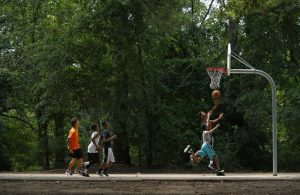
Or at least that’s the way things are supposed to work. But like so much else in Southern Dallas these days, things aren’t working the way they’re supposed to.
According to the TCEQ the Austin Asphalt facility is a portable asphalt batch plant operation. That means it wasn’t built specifically for its current Joppa site. It was moved there and it can be moved somewhere else.
In 2002 it first operated in Hockley County, a rural part of Northwest Texas near Lubbock some 400 miles west of Joppa. It moved to its current location in Joppa in 2008.
In 2002 the TCEQ let Austin Industries use what’s called a “SCREEN3” air model to determine if the air pollution from its asphalt batch plant’s was a threat to anyone in Hockley County. Again unsurprisingly, the firm hired by Austin Industries to do the computer modeling found it was “protective of human health.”
TCEQ says the Austin Industries’ asphalt plant has never been subject to any additional “impacts evaluation.” besides this 2002 review.
That means the only air modeling ever done for this Austin asphalt plant was while it was operating in rural Hockley County in 2002. There has been no air modeling of the plant since it came to Joppa in 2008.
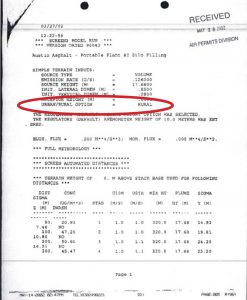
In 2002 the Austin plant was in West Texas and used a rural air model. In 2019 they’re still using for it for operation in Joppa.
Besides the most obvious and important difference in population density between unincorporated Hockley County near Lubbock and inner city Dallas, all of the variables in the 2002 modeling apply only to the Hockley County location. Meteorology, stack height, and surrounding terrain among them. In fact, the entire model was defaulted to a “rural” versus “urban” option in 2002. This renders the modeling scientifically useless in its current location in Joppa.
But that uselessness isn’t keeping the Executive Director of the Texas Commission on Environmental Quality from citing it to justify renewal of Austin’s air permit.
There’s also the matter of the age and limitations of the SCREEN3 model. In 2011 EPA replaced it with something called the “AERSCREEN” model. In doing so the agency called the old model “outdated“ and said “there are no valid reasons” to keep using SCREEN3.
And it’s not just the EPA. State environmental agencies, like the Arizona Department of Environmental Quality, have quit accepting SCREEN3 modeling.
Alex De Visscher, Associate Professor and Canada Research Chair in Air Quality and Pollution Control Engineering at the University of Calgary, writing in an 2013 text book entitled “Air Dispersion Modeling: Foundations and Applications,” said SCEEN3 is a “product of a previous generation of air dispersion modeling” and “is no longer a recommended model… it does not allow for multiple sources, and it does not include atmospheric chemistry or deposition.”
These exclusions are important. There are multiple sources of Particulate Matter 2.5 air pollution at Austin Industries’ plant in its Joppa location, including piles of raw material, and industrial combustion at the site. SCREEN 3 modeling didn’t and wouldn’t reflect these multiple sources of pollution. And of course when you’re talking about PM 2.5 pollution, as you are with an asphalt batch plant, the atmospheric chemistry and deposition, or fallout, is critical.
TCEQ’s own air modeling guidelines say so:
“Air dispersion models utilize dispersion coefficients to determine the rate of dispersion for a plume. Dispersion coefficients are influenced by factors such as land-use / land-cover (LULC), terrain, averaging period, and meteorological conditions. Evaluating the LULC within the modeling domain is an integral component to air dispersion modeling. The data obtained from a LULC analysis can be used to determine representative dispersion coefficients. The selection of representative dispersion coefficients may be as simple as selecting between rural or urban land-use types. For the ISC, ISC-PRIME, and SCREEN3 models, the dispersion coefficients are based on whether the area is predominately rural or urban. The classification of the land use in the vicinity of sources of air pollution is needed because dispersion rates differ between rural and urban areas.”
The TCEQ itself says it makes a fundamental difference whether the air model for a polluter is run for urban or rural terrain. Yet for over a decade TCEQ and Austin Asphalt have misused the results of a “rural” computer model to misleadingly assure inner-city Joppa residents that the company’s asphalt plant posed no harm.
What’s more, the modeling performed in 2002 only examined “asphalt vapors,” a made-up, vague pollutant category that can’t be monitored or measured. It didn’t examine Particulate Matter 2.5 pollution or specific Volatile Organic Compounds that make up those “vapors” and was therefore incomplete in the extreme.
So despite all the verbage the TCEQ’s Executive Director uses to tell Joppa residents th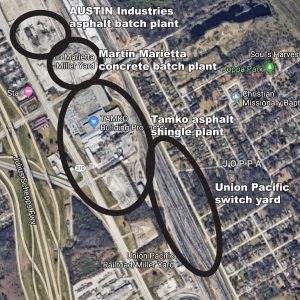 at past “air analysis” has shown Austin Industries’ plant to be protective of human health, in truth the only “analysis” ever done was performed 17 years ago in a sparsely-populated rural location 400 miles away from its current location, with what TCEQ admits are totally inaccurate modeling inputs by company consultants. It didn’t include all priority pollutants or even all sources of air pollution from the facility and the model used is now considered obsolete by EPA, modeling experts, and other state environmental agencies.
at past “air analysis” has shown Austin Industries’ plant to be protective of human health, in truth the only “analysis” ever done was performed 17 years ago in a sparsely-populated rural location 400 miles away from its current location, with what TCEQ admits are totally inaccurate modeling inputs by company consultants. It didn’t include all priority pollutants or even all sources of air pollution from the facility and the model used is now considered obsolete by EPA, modeling experts, and other state environmental agencies.
Joppa residents deserve better.
In its response to the Executive Director, Downwinders at Risk specifically requested TCEQ delay further regulatory action on this permit renewal until it can conduct a modern comprehensive air modeling impact analysis for Austin Asphalt’s current operation in Joppa that requires an evaluation of all on-site sources of pollution, including fugitive and mobile sources, on the Austin Asphalt site, off-site near-by sources of pollution within a three kilometer (1.86 mile) radius of Austin Asphalt’s facility, and representative monitored background concentrations obtained from local Joppa neighborhood monitoring as well as modeling of permitted maximums emission rates form all sources.
On September 11th the Texas Commission on Environmental Quality will take up the Austin Industries permit renewal at its headquarters in Austin. Both Legal Aid and Downwinders at Risk representatives will be present to answer any questions from the Commissioners but will not be allowed to make any statements. We’ll let you know the outcome.
One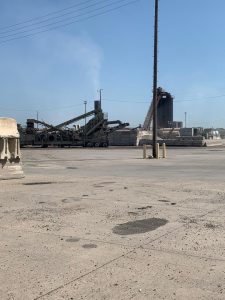 might reasonably ask why the City of Dallas itself isn’t fighting this permit renewal? After all in 2007, the city took on a string of proposed coal-fired power plants that it said would increase air pollution for Dallas. But to date that same city has never bothered to try and stop an industrial polluter from opening shop or renewing its permit in one of its most abused neighborhoods.
might reasonably ask why the City of Dallas itself isn’t fighting this permit renewal? After all in 2007, the city took on a string of proposed coal-fired power plants that it said would increase air pollution for Dallas. But to date that same city has never bothered to try and stop an industrial polluter from opening shop or renewing its permit in one of its most abused neighborhoods.
This dishonest use of a irrelevant model by the state’s discredited environmental agency shows why it’s imperative the City of Dallas – and all municipalities in Texas – change the way they do business and be proactive in addressing their environmental justice and environmental health issues in their own city limits.
Too often city representatives default to state or federal officials on the environment when they should be the first line of defense, not the last. City officials’ reliance on a failed state agency to perform its job as environmental protector is what caused Shingle Mountain. It’s what caused this situation in Joppa. To change that means changing both policies coming out of City Hall and current City Hall culture. Environmental Protection is a Do-It-Yourself proposition these days.
Downwinders Welcomes New Board Member Cindy Hua
 At our June board meeting, we welcomed Cindy Hua to membership on the Downwwinders Board.
At our June board meeting, we welcomed Cindy Hua to membership on the Downwwinders Board.
Cindy came to us via our monthly portable monitoring training, which she quickly mastered and now helps teach. She’s a SMU graduate student in Sustainability Design with a BA in Biology and committed to bridging STEAM education and environmental justice.
Her work is focused on building STEAM experiences that foster creativity and confidence to empower all people to create positive social and environmental change.
Cindy is already a central part of our continuing education program, and she’s looking forward to building partnerships with local schools and universities to educate students to address environmental issues within their community.
Beginning this fall we’re taking the portable training that attracted Cindy to our ranks out on the road to teach folks in their own groups and settings. We’re also drafting up a more formal relationship with area colleges for our technology lending library. Cindy will be in the middle of all this. We’re very grateful she’s joined our board and look forward to working with her.
Scenes from Shingle Mountain Fundraiser 5/30/19
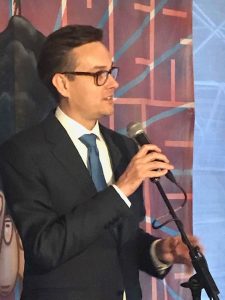
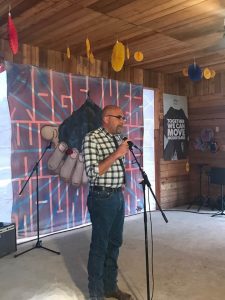
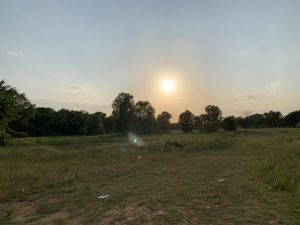

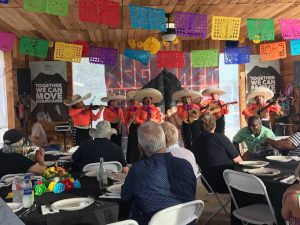
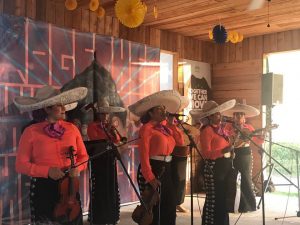
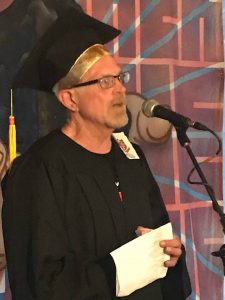

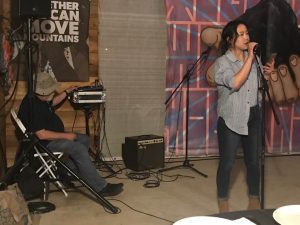
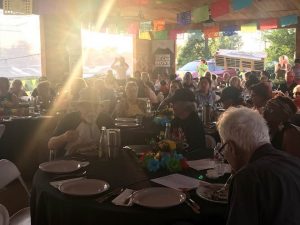

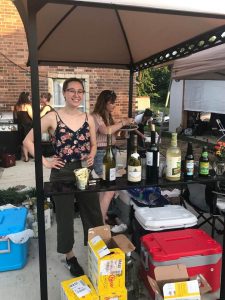
Read Dallas’ Shingle Mountain Restraining Order
Dallas Goes After Shingle M… by on Scribd
ROOT AND BRANCH 2019 Dec 5th-8th
3 Events to Make You a Better Activist
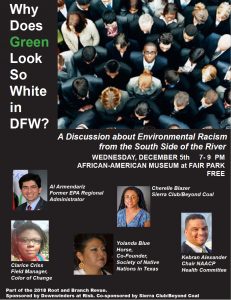

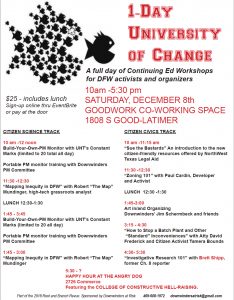
New Study Says Texas PM Pollution Ignored for Smog
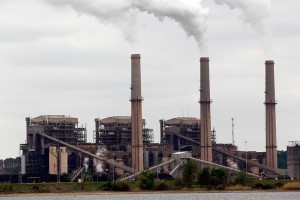 Regulators have been paying too much attention to the smog produced by Texas’ polluting coal plants, and not enough to the Sulfur Dioxide soaked Particulate Matter they emit according to a new report published last month in the Journal of the Air & Waste Management Association.
Regulators have been paying too much attention to the smog produced by Texas’ polluting coal plants, and not enough to the Sulfur Dioxide soaked Particulate Matter they emit according to a new report published last month in the Journal of the Air & Waste Management Association.
Rice University’s Daniel Cohan and his colleagues found residents downwind of coal plants would be far better off today had the state focused on cutting particle-forming sulfur dioxide emissions in addition to those that cause ozone.
“What I found eye-opening in this study is that most of the health damage is coming from particulate matter, but most of Texas’ focus on air pollution has been on ozone smog,” said Cohan. The problem is that even when particulate levels meet current standards, they are still health hazards.
“We know the higher the particulate matter levels, the more people die, both on a short-term correlation — when particulate matter levels are high one day, death rates are higher over the next few days — and also over long-term studies,” he said.
According to Cohen, “Particulate matter is the deadliest of all air pollutants, and it’s not just causing deaths in the way that you might think. It’s not only by respiratory diseases, but it’s also causing increases in rates of heart attacks and strokes. These particles are small enough to pass through the alveoli and enter the bloodstream. That lets them cause damage on all aspects of our bodily systems.”
